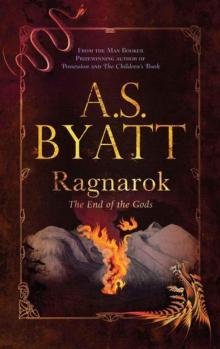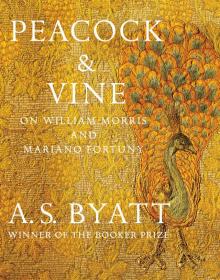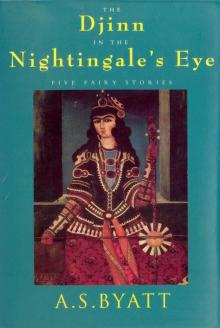- Home
- A. S. Byatt
Elementals Page 13
Elementals Read online
Page 13
The painter was in his corner, eating her dish of elvers and alioli. He addressed her directly for the first time, remarking that he was much in her debt, over these last weeks, for her good nose for herbs, for her tact with sugar and spice, for her command of sweet and sour, rich and delicate. You are a true artist, said the painter, gesturing with his fork.
Dolores turned on him. He had no right to mock her, she said. He was a true artist, he could reveal light and beauty in eggs and fishes that no one had seen, and which they would then always see. She made pastries and dishes that went out of the kitchen beautiful and came back mangled and mashed – they don’t notice what they’re eating, they’re so busy talking, and they don’t eat most of it, in case they grow fat, apart from the priests, who have no other pleasures. They order it all for show, for show, and it lasts a minute only until they put the knife to it, or push it around their plate elegantly with a fork.
The painter put his head on one side, and considered her red face as he considered the copper jugs, or the glassware, narrowing his eyes to a slit. He asked her if she knew the story St Luke told, of Christ in the house of Martha and Mary. No, she said, she did not. She knew her catechism, and what would happen to sinners at the Last Judgment, which was on the wall of the church. And about butchered martyrs, who were also on the walls of the church.
They were sisters, the painter told her, who lived in Bethany. Jesus visited them, from time to time, and rested there. And Mary sat at his feet and listened to his words, and Martha was cumbered with much serving, as St Luke put it, and complained. She said to the Lord, ‘Dost thou not care that my sister hath left me to serve alone? bid her therefore that she help me.’ And Jesus said to her, ‘Martha, Martha, thou art careful and troubled about many things: but one thing is needful, and Mary hath chosen that good part, which shall not be taken away from her.’
Dolores considered this, drawing her brows together in an angry frown. She said, ‘There speaks a man, for certain. There will always be serving, and someone will always be doomed to serving, and will have no choice or chance about the better part. Our Lord could make loaves and fishes from the air for the listeners, but mere mortals cannot. So we – Concepción and I – serve them whilst they have the better part they have chosen.’
And Concepción said that Dolores should be careful, or she would be in danger of blaspheming. She should learn to accept the station the Lord had given her. And she appealed to the painter, should Dolores not learn to be content, to be patient? Hot tears sprang in Dolores’s eyes. The painter said:
‘By no means. It is not a question of accepting our station in the world as men have ordered it, but of learning not to be careful and troubled. Dolores here has her way to that better part, even as I have, and, like mine, it begins in attention to loaves and fishes. What matters is not that silly girls push her work about their plates with a fork, but that the work is good, that she understands what the wise understand, the nature of garlic and onions, butter and oil, eggs and fish, peppers, aubergines, pumpkins and corn. The cook, as much as the painter, looks into the essence of the creation, not, as I do, in light and on surfaces, but with all the other senses, with taste, and smell, and touch, which God also made in us for purposes. You may come at the better part by understanding emulsions, Dolores, by studying freshness and the edges of decay in leaves and flesh, by mixing wine and blood and sugar into sauces, as well as I may, and likely better than fine ladies twisting their pretty necks so that the light may catch their pretty pearls. You are very young, Dolores, and very strong, and very angry. You must learn now, that the important lesson – as long as you have your health – is that the divide is not between the servants and the served, between the leisured and the workers, but between those who are interested in the world and its multiplicity of forms and forces, and those who merely subsist, worrying or yawning. When I paint eggs and fishes and onions, I am painting the godhead – not only because eggs have been taken as an emblem of the Resurrection, as have dormant roots with green shoots, not only because the letters of Christ’s name make up the Greek word for fish, but because the world is full of light and life, and the true crime is not to be interested in it. You have a way in. Take it. It may incidentally be a way out, too, as all skills are. The Church teaches that Mary is the contemplative life, which is higher than Martha’s way, which is the active way. But any painter must question, which is which? And a cook also contemplates mysteries.’
‘I don’t know,’ said Dolores, frowning. He tilted his head the other way. Her head was briefly full of images of the skeletons of fishes, of the whirlpool of golden egg-and-oil in the bowl, of the pattern of muscles in the shoulder of a goat. She said, ‘It is nothing, what I know. It is past in a flash. It is cooked and eaten, or it is gone bad and fed to the dogs, or thrown out.’
‘Like life,’ said the painter. ‘We eat and are eaten, and we are very lucky if we reach our three score years and ten, which is less than a flash in the eyes of an angel. The understanding persists, for a time. In your craft and mine.’
He said, ‘Your frown is a powerful force in itself. I have an idea for a painting of Christ in the house of Martha and Mary. Would you let me draw you? I have noticed that you were unwilling.’
‘I am not beautiful.’
‘No. But you have power. Your anger has power, and you have power yourself, beyond that.’
She had the idea, then, over the weeks and months when he visited from time to time and sketched her, and Concepción, or ate the alioli and supped her red peppers and raisins, praising the flavours, that he would make her heroic, a kind of goddess wielding spit and carving knife instead of spear and sword. She found herself posing, saw him noting the posing, and tried to desist. His interest in the materials of her art did indeed fire her own interest in them. She excelled herself, trying new combinations for him, offering new juices, frothing new possets. Concepción was afraid that the girl would fall in love with the artist, but in some unobtrusively clever way he avoided that. His slit stare, his compressed look of concentration, were the opposite of erotic. He talked to the girl as though she were a colleague, a partner in the mystery of his trade, and this, Concepción saw without wholly knowing that she saw it, gave Dolores a dignity, a presence, that amorous attentions would not have done. He did not show the women the sketches of themselves, though he gave them small drawings of heads of garlic and long capsicum to take to their rooms. And when, finally, the painting of Christ in the House of Martha and Mary was finished, he invited both women to come and look at it in his studio. He seemed, for the first time, worried about their reaction.
When they saw the painting, Concepción drew in her breath. There they both were, in the foreground at the left. She herself was admonishing the girl, pointing with a raised finger to the small scene at the top right-hand corner of the painting – was it through a window, or over a sill, or was it an image of an image on a wall? it was not clear – where Christ addressed the holy staring woman crouched at his feet whilst her sister stood stolidly behind, looking also like Concepción, who had perhaps modelled for her from another angle. But the light hit four things – the silvery fish, so recently dead that they were still bright-eyed, the solid white gleam of the eggs, emitting light, the heads of garlic, half-peeled and life-like, and the sulky, fleshy, furiously frowning face of the girl, above her fat red arms in their brown stuff sleeves. He had immortalised her ugliness, Concepción thought, she would never forgive him. She was used to paintings of patient and ethereal Madonnas. This was living flesh, in a turmoil of watchful discontent. She said, ‘Look how real the eyes of the fishes are,’ and her voice trailed foolishly away, as she and the painter watched the live Dolores watch her image.
She stood and stared. She stared. The painter shifted from foot to foot. Then she said, ‘Oh yes, I see what you saw, how very strange.’ She said, ‘How very strange, to have been looked at so intently.’ And then she began to laugh. When she laughed, all the down-drooping lines
of cheek and lip moved up and apart. The knit brows sprang apart, the eyes shone with amusement, the young voice pealed out. The momentary coincidence between image and woman vanished, as though the rage was still and eternal in the painting and the woman was released into time. The laughter was infectious, as laughter is; after a moment Concepción, and then the painter, joined in. He produced wine, and the women uncovered the offering they had brought, spicy tortilla and salad greens. They sat down and ate together.
A. S. BYATT
Elementals
A. S. Byatt is famed for her short fiction, collected in Sugar and Other Stories, The Matisse Stories, and The Djinn in the Nightingale’s Eye. Her full-length novels include the Booker Prize–winning Possession and the trilogy sequence of novels The Virgin in the Garden, Still Life, and Babel Tower. She has also published four volumes of critical work, of which Imagining Characters is the most recent. She lives in London.
ALSO BY A. S. BYATT
FICTION
The Shadow of the Sun
The Game
The Virgin in the Garden
Still Life
Sugar and Other Stories
Possession: A Romance
Angels and Insects
The Matisse Stories
Babel Tower
The Djinn in the Nightingale’s Eye
CRITICISM
Degrees of Freedom: The Novels of Iris Murdoch
Unruly Times: Wordsworth and Coleridge
Passions of the Mind: Selected Writings
Imagining Characters (with Ignês Sodré)
FIRST VINTAGE INTERNATIONAL EDITION, JULY 2000
Copyright © 1998 by A. S. Byatt
Vintage is a registered trademark and Vintage International and colophon
are trademarks of Random House, Inc.
“Baglady” appeared in the Daily Telegraph, and “A Lamia in the Cévennes”
in The Atlantic Monthly, © 1995; “Jael” in The Guardian, © 1997;
“Christ in the House of Martha and Mary” on Word Pictures, BBC Radio 3,
and in You magazine, Mail on Sunday, and “Crocodile Tears” in
The Paris Review, © 1998.
The Library of Congress has cataloged the Random House edition as follows:
Byatt, A. S. (Antonia Susan).
Elementals: stories of fire and ice / A. S. Byatt.
p. cm.
1. Polarity—Fiction. I. Title.
PR6052.Y2E44 1999
823’.914—dc21 99-10627
www.vintagebooks.com
www.randomhouse.com
eISBN: 978-0-307-42573-7
v3.0

 The Children's Book
The Children's Book Babel Tower
Babel Tower The Matisse Stories
The Matisse Stories Peacock & Vine: On William Morris and Mariano Fortuny
Peacock & Vine: On William Morris and Mariano Fortuny Elementals: Stories of Fire and Ice
Elementals: Stories of Fire and Ice Sugar and Other Stories
Sugar and Other Stories Possession
Possession Little Black Book of Stories
Little Black Book of Stories The Djinn in the Nightingale's Eye
The Djinn in the Nightingale's Eye The Virgin in the Garden
The Virgin in the Garden The Game
The Game The Biographer's Tale
The Biographer's Tale A Whistling Woman
A Whistling Woman Ragnarok
Ragnarok Angels & Insects: Two Novellas
Angels & Insects: Two Novellas Ragnarok: the End of the Gods (Myths)
Ragnarok: the End of the Gods (Myths) Peacock & Vine
Peacock & Vine The Djinn in the Nightingale's Eye (Vintage International)
The Djinn in the Nightingale's Eye (Vintage International) Angels and Insects
Angels and Insects The Arabian Nights: Tales from a Thousand and One Nights (Modern Library Classics)
The Arabian Nights: Tales from a Thousand and One Nights (Modern Library Classics) Elementals
Elementals